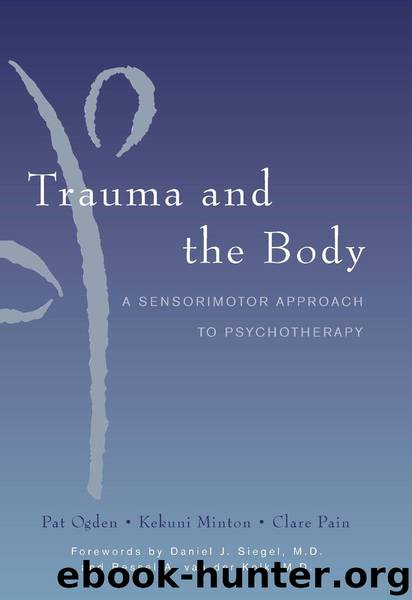Trauma and the Body: A Sensorimotor Approach to Psychotherapy (Norton Series on Interpersonal Neurobiology) by Ogden Pat & Pain Clare & Minton Kekuni

Author:Ogden, Pat & Pain, Clare & Minton, Kekuni [Ogden, Pat]
Language: eng
Format: epub
Publisher: Norton
Published: 2006-10-16T20:00:00+00:00
Orbitofrontal Cortex
In the field of neuroscience, particularly in research related to trauma and/or attachment, the role of the orbitofrontal cortex has stimulated increasing interest. The orbitofrontal cortex is the part of the frontal lobe that lies just above the orbit of the eyes, in a position that facilitates direct inputs from a number of adjoining cortical and subcortical brain areas: the dorsome-dial thalamus, temporal cortex, ventral tegmental area, olfactory system, and the amygdala. Its outputs also extend to both cortical and subcortical brain regions, including the cingulate cortex, hippocampal formation, temporal cortex, lateral hypothalamus, and amygdala. Its complex system of inputs provide the orbitofrontal cortex with a wealth of information about what is happening in the environment and what plans are being organized by other cortical areas. In turn, its communication outputs affect a variety of behaviors and physiological responses, including emotional and autonomic responses organized by the amygdala. The orbitofrontal cortex also plays a role in mediating autonomic and behavioral responses via its connections with the cingulate cortex. In sum, the orbitofrontal cortex is uniquely situated to mediate communication between subcortical and cortical systems.
The orbitofrontal system may also be involved in “the regulation of the body state and in the reflection of changes in that state” (Luria, 1980, Schore, 2003a) and thus may play an important role in the regulation of arousal within the window of tolerance. In its function as part of the attachment action system, the orbitofrontal cortex is believed to enable cortically processed information concerning the environment (e.g., visual and auditory stimuli emanating from a facial expression) to be integrated with subcortically processed information in the internal visceral environment, thus facilitating the association of incoming information from the external environment with motivational and emotional states. In the mother–infant dyadic interaction, these experiences, in which the perception of facial expression is integrated with the sensations associated with optimal body states, become the basis for secure attachment and, in turn, facilitate the optimal development of the orbitofrontal cortex (Schore, 2003a).
It has been suggested that abuse and/or neglect over the first 2 years of life negatively impacts the maturation of the orbital prefrontolimbic system (Schore, 1994, 2003a, 2003b). Different theorists propose different mechanisms of action for this process. Martin, Spicer, Lewis, Gluck, and Cork(1991) suggested that in early postnatal life, maintaining critical levels of tactile input of specific quality and emotional content is important for normal brain maturation, whereas Greenough and Black (1992) proposed that multiple sensory inputs, derived from contact with the mother during feeding/ nursing, are crucial in shaping the development of the orbitofrontal cortex. Schore (2003a) argued that sensory inputs are just one aspect of a larger process of dyadic regulation of arousal and affect, within the context of secure attachment, that contributes to optimal synaptic pruning:
The early social environment, mediated by the primary caregiver, directly influences the final wiring of the circuits in the infant brain that are responsible for the future social and emotional coping capacities of the individual. The ultimate product of this
Download
This site does not store any files on its server. We only index and link to content provided by other sites. Please contact the content providers to delete copyright contents if any and email us, we'll remove relevant links or contents immediately.
Unwinding Anxiety by Judson Brewer(72009)
The Art of Coaching by Elena Aguilar(52202)
The Fast Metabolism Diet Cookbook by Haylie Pomroy(20922)
Rewire Your Anxious Brain by Catherine M. Pittman(18320)
Healthy Aging For Dummies by Brent Agin & Sharon Perkins RN(16928)
Talking to Strangers by Malcolm Gladwell(12887)
The Art of Thinking Clearly by Rolf Dobelli(9929)
Crazy Rich Asians by Kevin Kwan(8894)
Mindhunter: Inside the FBI's Elite Serial Crime Unit by John E. Douglas & Mark Olshaker(8708)
The Compound Effect by Darren Hardy(8523)
Periodization Training for Sports by Tudor Bompa(7929)
Becoming Supernatural by Dr. Joe Dispenza(7845)
Tools of Titans by Timothy Ferriss(7824)
Wonder by R. J. Palacio(7747)
Crystal Healing for Women by Mariah K. Lyons(7717)
Bodyweight Strength Training by Jay Cardiello(7680)
Therapeutic Modalities for Musculoskeletal Injuries, 4E by Craig R. Denegar & Ethan Saliba & Susan Saliba(7601)
Should I Stay or Should I Go? by Ramani Durvasula(7435)
Change Your Questions, Change Your Life by Marilee Adams(7384)
